Early Christian Monuments of Ravenna: Ravenna has a unique collection of early Christian mosaics and monuments, most of the early Christian monuments were constructed in the 5th and 6th centuries. Ravenna was the seat of the Roman Empire in the 5th century. In the 6th century, the Ostrogothic King Theodoric had his favourite residences in Ravenna, Pavia and Verona. Ravenna was the seat of Byzantine Italy until the 8th century. Ravenna developed into an important centre of Christian art and culture. Galla Placidia was the Empress consort of the Roman Emperor Constantine III, she was a fervent Christian, she was involved in the building and restoration of several churches in Ravenna. The Early Christian Monuments of Ravenna are adorned with breathtaking mosaics. The eight Early Christian Monuments of Ravenna are: the Mausoleum of Galla Placidia, built in 425-450; the Neonian Baptistery, built in 458; the Arian Baptistery, built in 500; the Archiepiscopal Chapel, built in 500; the Basilica Sant'Apollinare Nuovo, built in 504; the Mausoleum of Theodoric, built in 520 just outside Ravenna; the Basilica of San Vitale, built in 526-547 and the Basilica Sant'Apollinare in Classe, built in 549. The mosaics of the San Vitale and the mosaics of the Euphrasian Basilica in Croatia are among the most magnificent Byzantine art in Europe. The Palatine Chapel of the Aachen Cathedral was inspired by the San Vitale in Ravenna and the duomo in Florence also was based on the San Vitale. The Early Christian Monuments of Ravenna were declared a UNESCO World Heritage in 1996.
www.werelderfgoedfotos.nl © Copyright World Heritage Photos
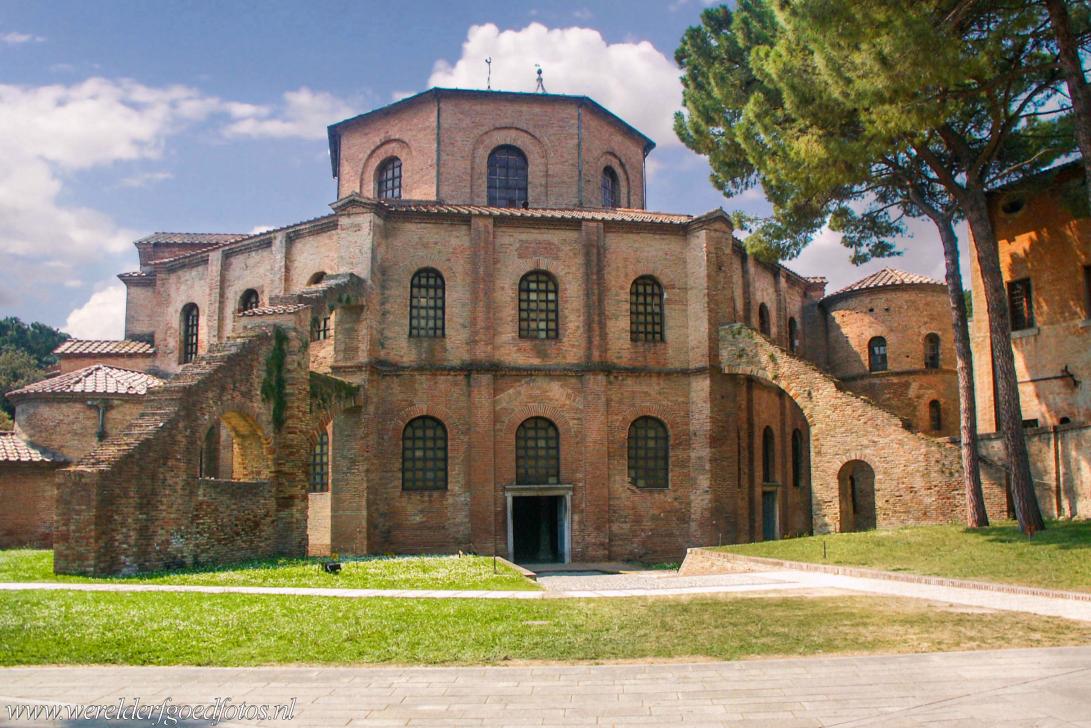
Early Christian Monuments of Ravenna: The Basilica of San Vitale is one of the most important monuments of Early Christian art in Italy. The San Vitale in Ravenna was built on the site where the Saint Vitalis was martyred and then buried alive. The San Vitale was consecrated in 548 AD. The basilica is renowned for its amazing Byzantine mosaics. The Early Christian Monuments of Ravenna were declared a UNESCO World Heritage in 1996.

Early Christian Monuments of Ravenna: The Basilica of San Vitale is one of the most important monuments of Early Christian art in Italy. The San Vitale in Ravenna was built on the site where the Saint Vitalis was martyred and then buried alive. The San Vitale was consecrated in 548 AD. The basilica is renowned for its amazing Byzantine mosaics. The Early Christian Monuments of Ravenna were declared a UNESCO World Heritage in 1996.
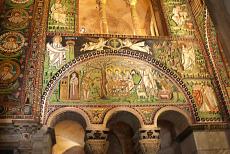
Early Christian Monuments of Ravenna: The Basilica of San Vitale is a beautiful domed church in the Byzantine style. The church has an octogonal plan. The walls of the basilica are adorned with spectacular Byzantine mosaics, the ceiling of the apse is adorned with Byzantine mosaics in gold and green. The Palatine Chapel of Aachen Cathedral in Germany was inspired by the San Vitale in Ravenna.
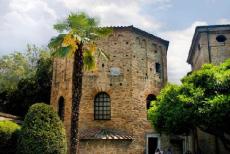
Early Christian Monuments of Ravenna: The Neonian Baptistery is also known as the Orthodox Baptistery. The octagonal shaped Neonian Baptistery (Battistero Neoniano) was probably built in the beginning of the 5th century. The baptistery was constructed of red brick, there are four niches in the exterior walls. The centre of the octagonal cupola is decorated with a magnificent early Christian mosaic.
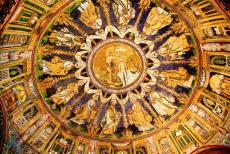
Early Christian Monuments of Ravenna: The dome of the Neonian Baptistery is adorned with a 5th century mosaic, it depicts the Baptism of Christ by John the Baptist in the River Jordan, it is one of the oldest mosaic scenes of the Baptism of Christ inside a building. The baptistery is also known as the Orthodox Baptistery. The Neonian Baptistery (Battistero Neoniano) is a UNESCO World Heritage.
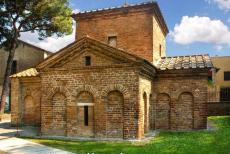
The Mausoleum of Galla Placidia was built in 425-450, the mausoleum is one of the oldest Early Christian Monuments in Ravenna. The mausoleum is decorated with mosaics. Ravenna was the seat of the Roman Empire in the 5th century and of Byzantine Italy until the 8th century. The city of Ravenna developed into an important centre of Christian art and culture. The Mausoleum of Galla Placidia is part of the UNESCO World Heritage: Early Christian Monuments of Ravenna.
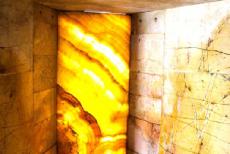
Early Christian Monuments of Ravenna: The window openings of the Mausoleum of Galla Placidia are covered with thin alabaster stone sheets. The outside of the mausoleum is sober, but the interior is lavishly embellished with mosaics. The mausoleum was probably built as an oratory. There is reasonable doubt whether the Mausoleum of Galla Placidia really served as her tomb because Empress Galla Placidia died in Rome in 450 AD
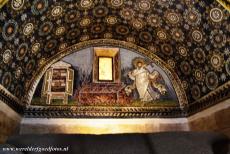
Early Christian Monuments of Ravenna: The Mausoleum of Galla Placidia is renowned for its breathtaking Byzantine mosaics. The mosaics depicting a starry sky on the barrel vault inspired Cole Porter to write the famous song 'Night and Day', Galla Placidia was the Empress consort of the Roman Emperor Constantine III, she was a fervent Christian. Galla Placidia was involved in the building and restoration of several churches in and around Ravenna.
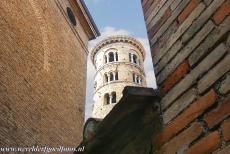
Early Christian Monuments of Ravenna: The bell-tower of the Basilica Sant'Apollinare Nuovo dates back to the 9th or 10th century. The Basilica Sant'Apollinare Nuovo was built around 500 AD as an Arian Cathedral and dedicated to Christ. It was consecrated into a Catholic church in 561. The basilica was named after the first bishop of Ravenna. The Early Christian Monuments of Ravenna were inscribed on the UNESCO World Heritage List in 1996.
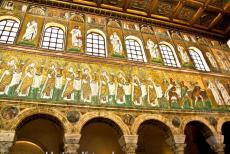
Early Christian Monuments of Ravenna: The Basilica Sant'Apollinare Nuovo is adorned with an early 6th century mosaic on the two side walls. The row top of the mosaics depict scenes from the life of Christ. The halo around the head of Christ in each scene is almost certainly a Catholic addition. The Basilica Sant'Apollinare Nuovo is one of the most important buildings from this period in European religious art. The basilica is a UNESCO World Heritage
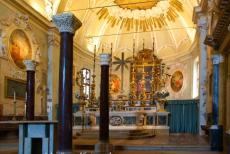
Early Christian Monuments of Ravenna: The apse of the Basilica Sant'Apollinare Nuovo contains several Roman columns and an altar dating from the 16th and 18th centuries, the walls of the apse were originally covered with mosaics such as the two side walls, but these were removed during renovations in the 16th century. The Sant'Apollinare Nuovo was built by the Ostrogoth King Theodoric the Great next to his palace.
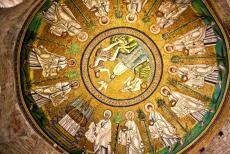
The Arian Baptistery (Battistero degli Ariani) was built in 500 AD, it has an octogonal plan and four small apses. Nothing remains of the mosaics that once covered the walls, but the dome still contains a mosaic: The Baptism of Christ surrounded by the twelve apostles. The baptistery was converted into a Roman Catholic church in 540, when the Byzantine Empire conquered the city of Ravenna, bringing Arianism in Italy to an end. The baptistery is a UNESCO World Heritage.
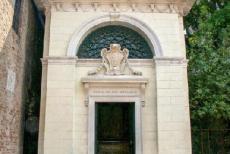
The tomb of Dante in the city of Ravenna. The Italian philosopher and writer Dante Alighieri was exiled from Florence, he moved to Ravenna where he died in 1321. Florence came to regret the exile of the famous Dante and made numerous requests for the return of his remains. Ravenna refused. Nevertheless, a tomb was built for Dante in the Santa Croce in Florence, but the tomb in Florence has been empty ever since, his body rests in this tomb in Ravenna.
